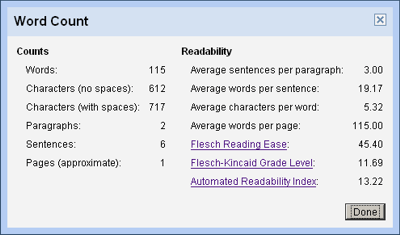Sunday, July 22, 2007
Google Docs Word Count Enhancements

The word count feature available from the Google Docs file menu has added a couple of neat features, Googlified reports. Not only does it count words, characters, paragraphs, or things like average words per sentences. It now also includes the “Flesch Reading Ease" value, a “Flesch-Kinkaid Grade Level,” as well as an “Automated Readability Index.” According to Wikipedia, which Google links from their dialog, the Flesch scores are “readability tests designed to indicate how difficult a reading passage is to understand”. Similarly, the Automated Readaibility Index (ARI for short) is “designed to gauge the understandability of a text," its output being “an approximate representation of the U.S. grade level needed to comprehend the text.”
Let’s pitch two pieces of text against each other: Simple English Wikipedia’s entry on “moon” vs normal Wikipedia’s entry for that word.
| Type | Simple English Wikipedia | Normal Wikipedia |
|---|---|---|
| Text | A moon is a large, usually ball shaped object that goes around (orbits) a planet. The Earth has only one moon. Some other planets have many moons, and some have none. When people write just “the moon”, they are usually talking about the moon of the Earth. Some people refer to it as Luna, the Latin word for it. Anything that goes around a planet is called a satellite. Moons are natural satellites. People also use rockets to send machines into orbit around the Earth. These machines are called artifical (man-made) satellites. |
The Moon (Latin: Luna) is Earth’s only natural satellite and the fifth largest moon in the Solar System. The average centre-to-centre distance from the Earth to the Moon is 384,403 kilometres (238,857 miles),a which is about 30 times the diameter of the Earth. The Moon has a diameter of 3,474 kilometres (2,159 miles)[1] — slightly more than a quarter that of the Earth. This means that the volume of the Moon is only 1/50th that of Earth. The gravitational pull at its surface is about a 1/6th of Earth’s. The Moon makes a complete orbit around the Earth every 27.3 days, and the periodic variations in the geometry of the Earth-Moon-Sun system are responsible for the lunar phases that repeat every 29.5 days. |
| Words | 93 | 138 |
| Average words per sentence: | 10.33 | 17.25 |
| Flesch Reading Ease | 68.99 | 75.30 |
| Flesch-Kincaid Grade Level | 6.20 | 7.04 |
| Automated Readability Index | 5.87 | 7.33 |
>> More posts
Advertisement
This site unofficially covers Google™ and more with some rights reserved. Join our forum!
